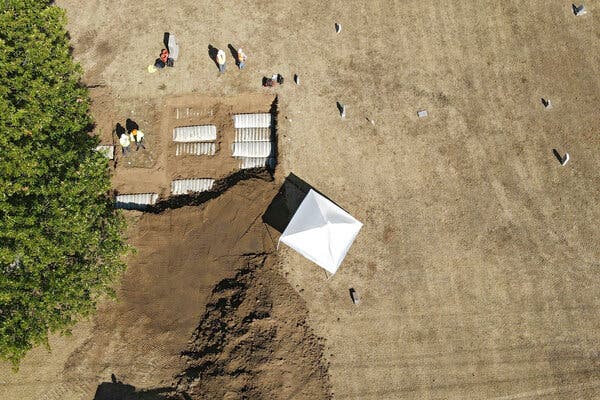Supported by
3 More Victims of 1921 Tulsa Race Massacre Found With Gunshot Wounds
Officials are exhuming bodies to learn more about the victims of one of the worst racial attacks in U.S. history.

Three victims of the 1921 Tulsa Race Massacre, whose remains were exhumed along with those of eight others, were found to have gunshot wounds, investigators announced on Friday, in the latest findings from research about one of the worst racial attacks in U.S. history.
G.T. Bynum, the mayor of Tulsa, Okla., announced in 2018 that the city would begin searching for and analyzing the bodies of victims of the massacre to learn more about their identities and causes of death.
Between 36 and 300 people are thought to have died during the massacre, officials have said, however only 26 death certificates were issued in connection to it.
“The people that we are searching for, our fellow Tulsans, they’re not just names in history,” Mr. Bynum said at a news conference on Friday. “These are our neighbors who were murdered in horrible ways.”
Investigators are looking for “simple wooden caskets” that fit a variety of parameters that could indicate a possible victim of the massacre, according to Kary Stackelbeck, a state archaeologist.
“Two of those gunshot victims display evidence of munitions from two different weapons, meaning that those two individuals were shot with at least two different kinds of arms,” Dr. Stackelbeck said. “The third individual who is a gunshot victim also displays evidence of burning.”
The bodies were exhumed from wooden caskets in Oaklawn Cemetery near where the body of C.L. Daniel — the first person identified through this project — was found and identified last month, Dr. Stackelbeck said in a recent interview.
The three gunshot victims were not named at the news conference and were referred to by their burial numbers. Their wounds came from a variety of bullet calibers and the wounds were on different parts of their bodies, including their torsos and an ankle, said Phoebe Stubblefield, an anthropologist at the University of Florida.
As of the end of the day on Friday, 47 sets of remains had been exhumed, at least one of which was a woman, Dr. Stubblefield said.
Tulsa officials are working with a lab, Intermountain Forensics, on DNA and genealogical analysis to better understand who died during the massacre.
The Tulsa Race Massacre began on May 31, 1921, after a Black man was accused of attacking a white woman. A white mob descended on the courthouse where the man was being held; he would later be cleared of guilt. When the white mob confronted a group of Black men, shots were fired and a fight broke out.
The white mob then went to Greenwood, a successful community known as Black Wall Street. In less than 24 hours, the mob had destroyed the community, killed and injured hundreds and left 8,000 to 10,000 people homeless.
During the news conference on Friday, Dr. Stubblefield thanked Tulsans for being engaged and invested in the discoveries of those who died during the massacre.
“You’re helping us to restore the history to those victims and their descendants of the Tulsa Race Massacre,” she said.
Audra D. S. Burch contributed reporting.
Hank Sanders is a Times reporter and a member of the 2024-25 Times Fellowship class, a program for journalists early in their careers. More about Hank Sanders
Advertisement
